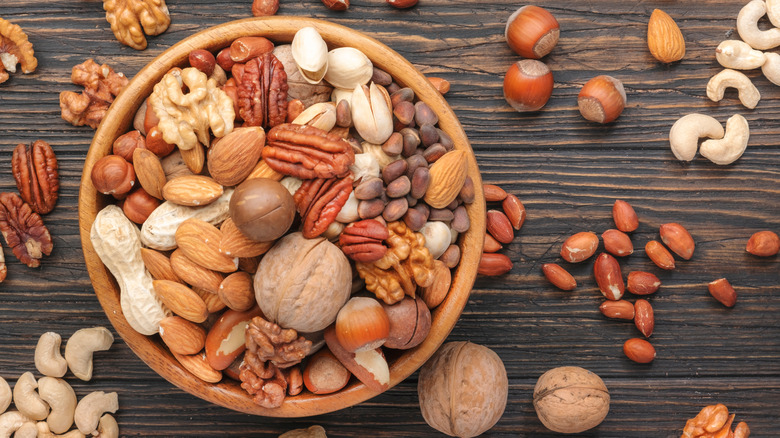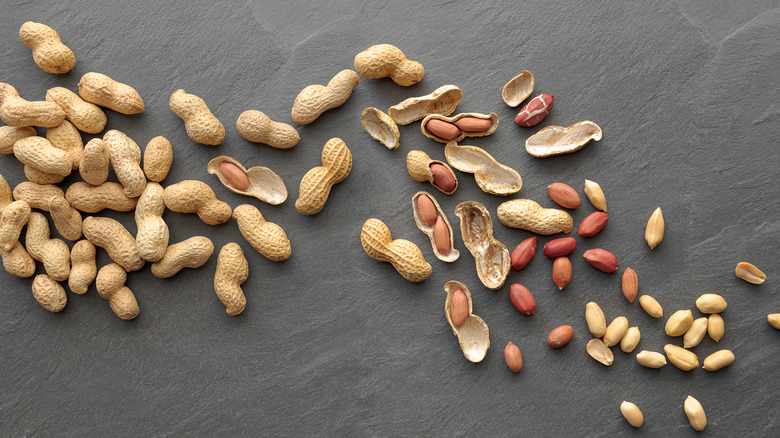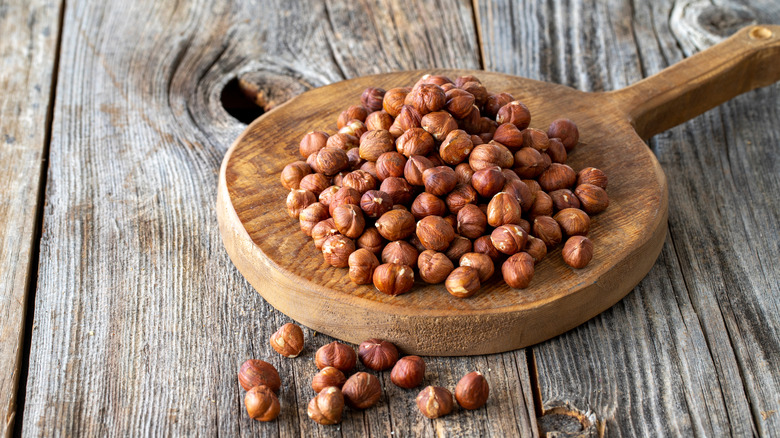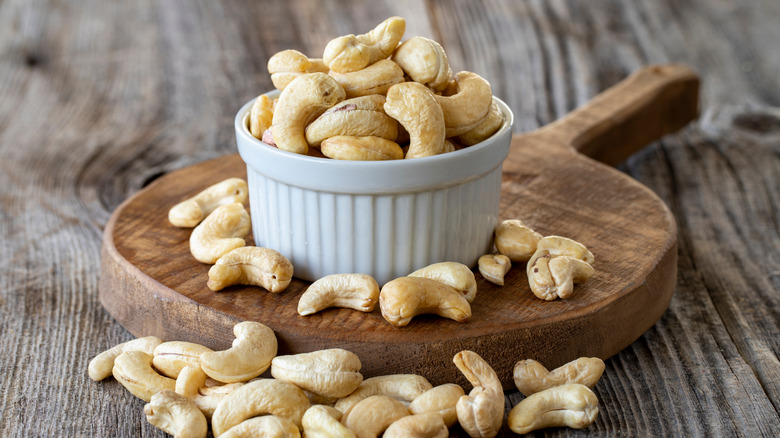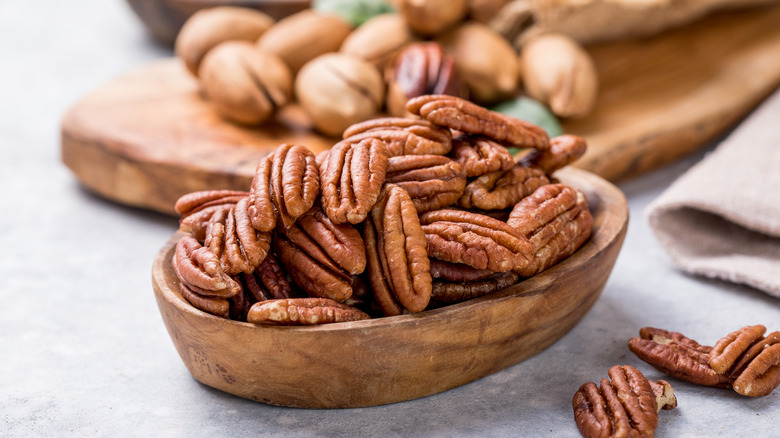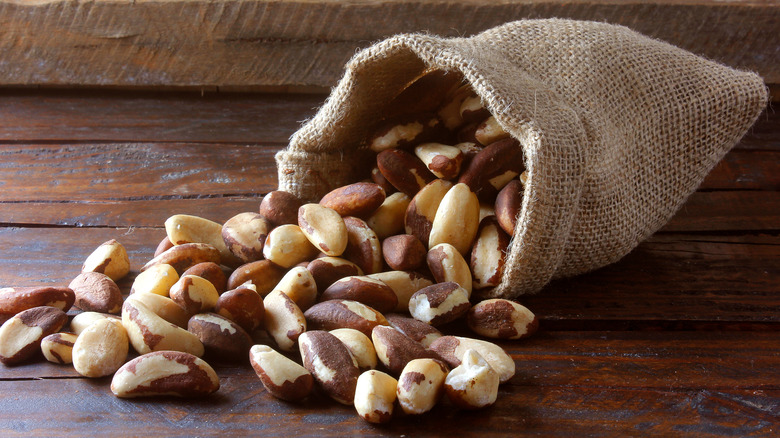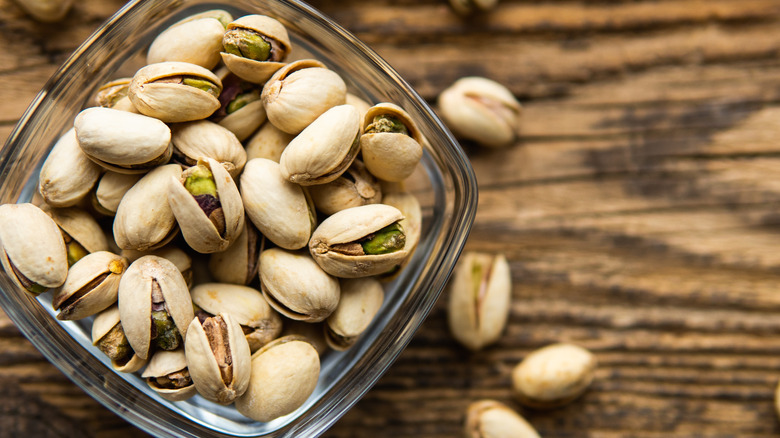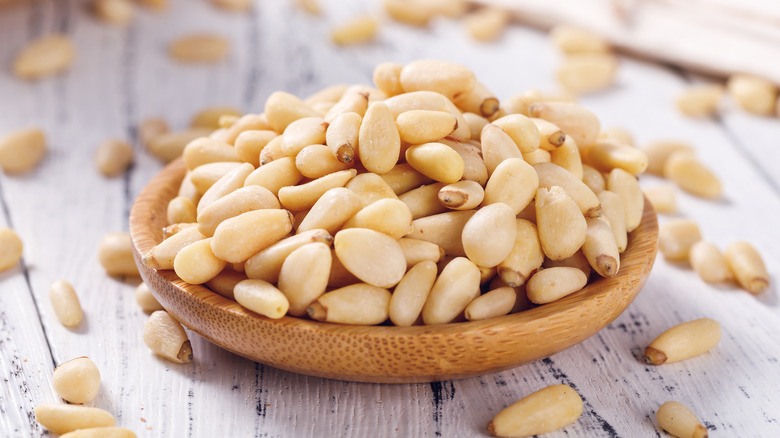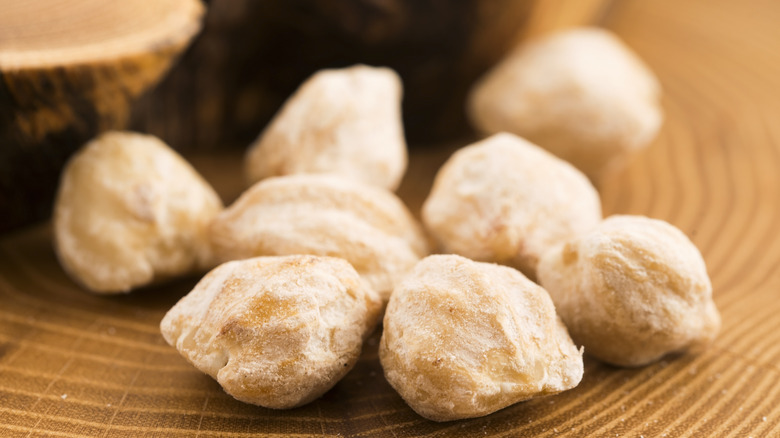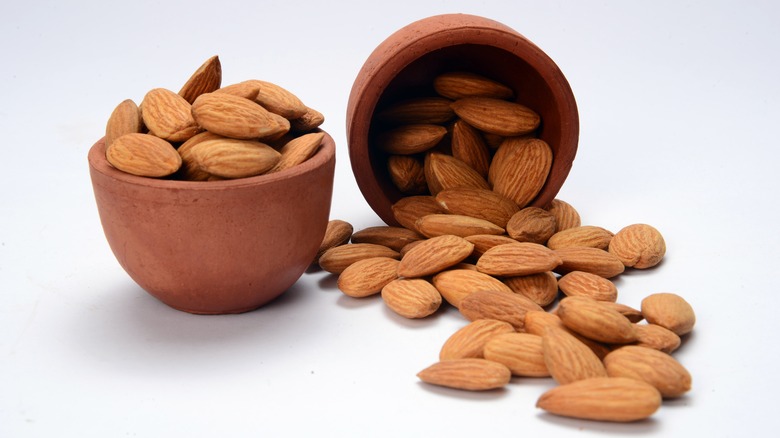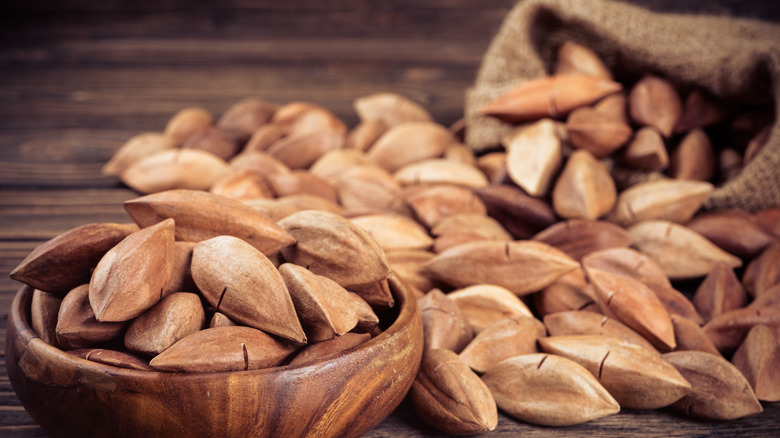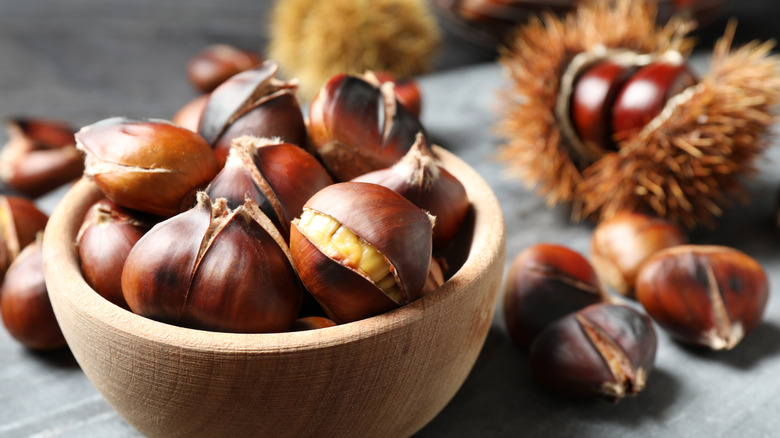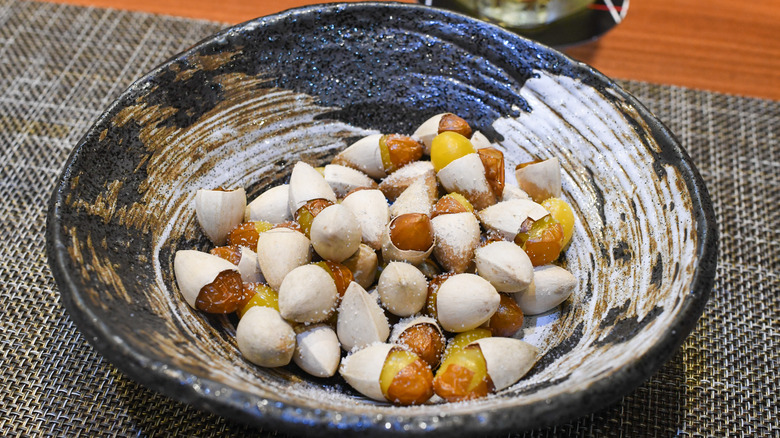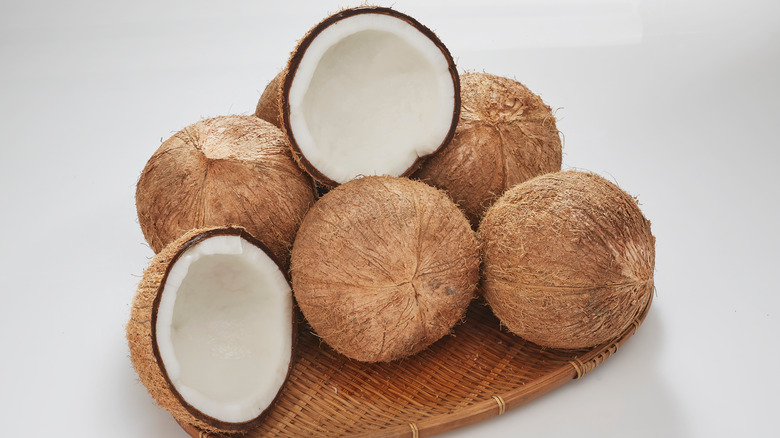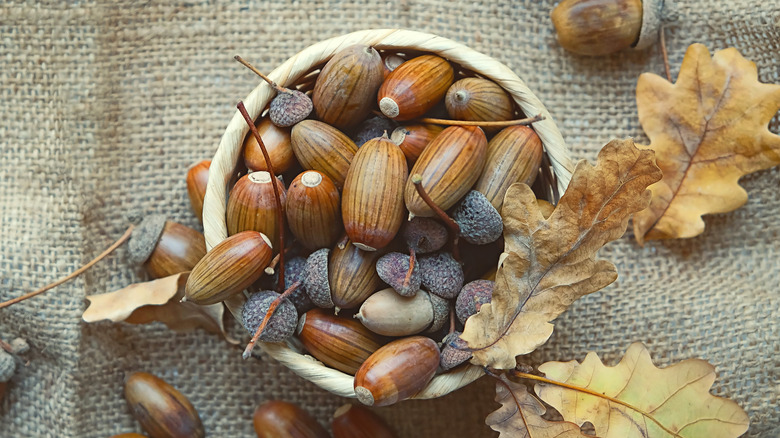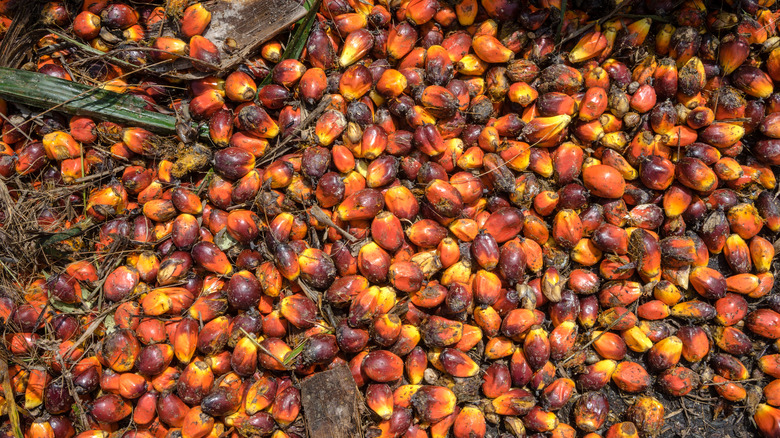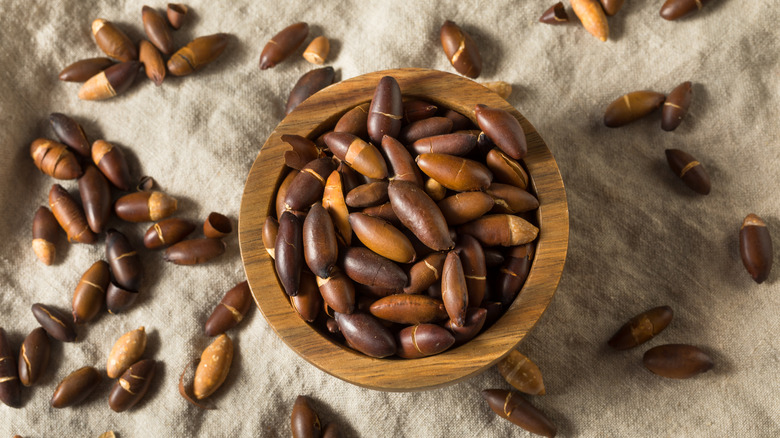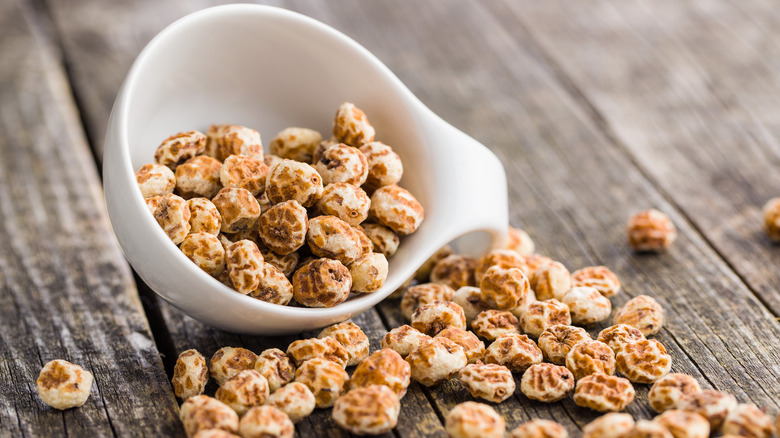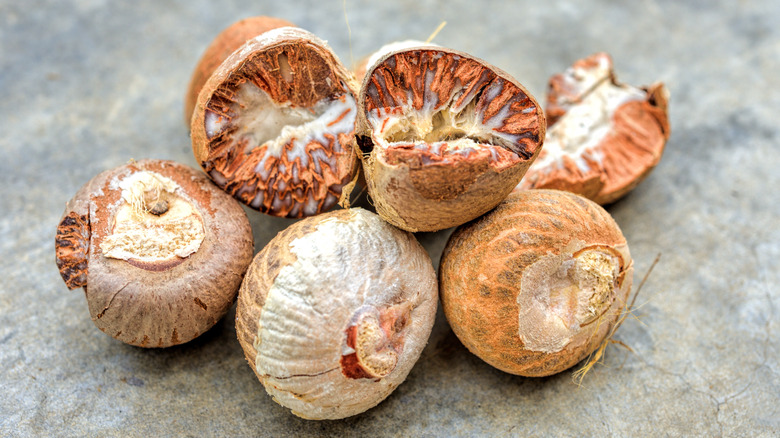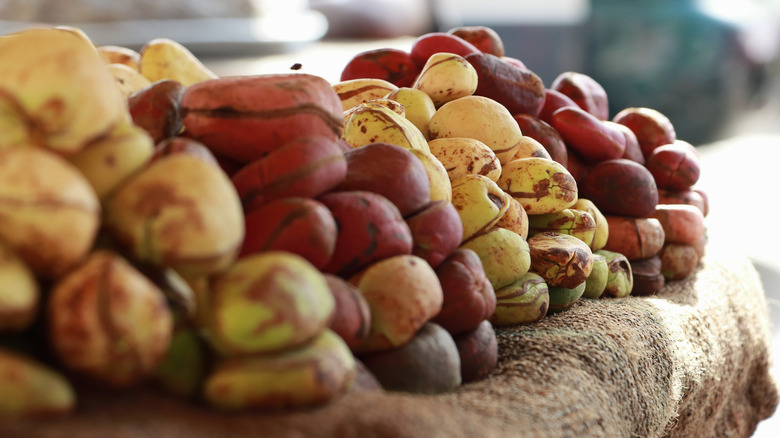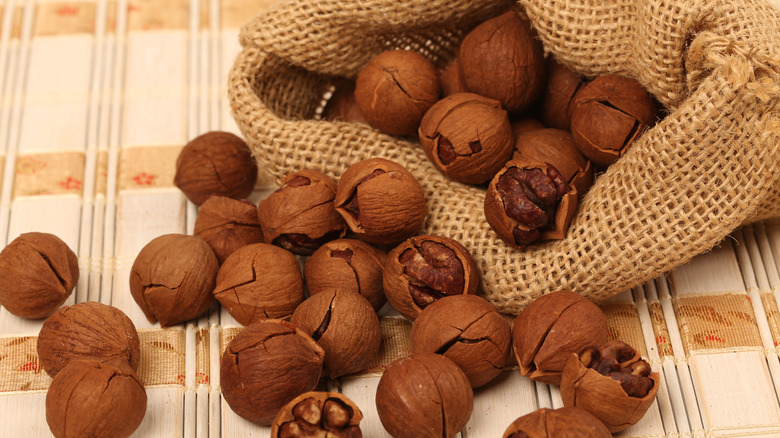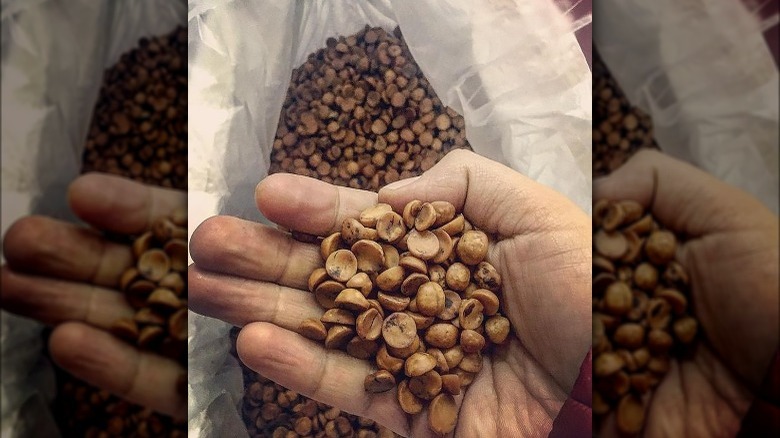25 Most Popular Types Of Nuts, Explained
Nuts are clouded in controversy. A high-fat content often leaves eaters wondering, "are they healthy or not?" while the dangers of nuts as allergens and choking hazards bring some to wonder if nuts should be forbidden in certain situations. Plus, to make matters more confusing, many foods long considered to be nuts are, in fact, seeds, legumes, or fruits. You could say that nuts are misunderstood.
However, once you get past their hard shells, nuts are brimming with nutrients and a range of flavors you'll want to add to your culinary repertoire. They might be small, but nuts are packed with antioxidants, fiber, and omega-3 fatty acids. Thanks to their nutritional profile, nuts are believed to assist with weight management, heart function, and gut health, as well as decrease cholesterol, inflammation, and the risk of certain chronic conditions, according to Healthline.
On top of these impressive health benefits, it's hard to think of a more convenient snack that will fill you up in a handful. (And a handful or two at most is generally considered to be a suitable portion size, registered dietitian Kathy McManus tells Harvard Health Publishing.) While anyone with a nut allergy needs to be vigilant with their consumption due to cross-contamination, for the most part, nuts are suitable for most diets. Enjoy nuts as a salty snack, incorporate them into your baking, or sprinkle them as garnish.
Peanuts
You would think that having the word nut in their name would make peanuts an obvious member of the category. However, they are technically legumes. Nonetheless, in practice, peanuts are treated as a nut — possibly the first one you encountered as a child. On top of this double identity, Healthline indicates that peanuts are classified as oilseeds since they are made of about 50% fat. This characteristic means that a large proportion of peanuts are used to make peanut oil worldwide.
Fats aside, peanuts are an impressive source of plant protein with around 25 grams per 100 grams, topping all other nuts and making them an excellent option for vegetarians, according to the APC. As for micronutrients, APC lists biotin, niacin, magnesium, copper, and vitamin E among the top contenders. In turn, these minerals promote bone, heart, and brain health. Plus, you'll get plenty of antioxidants and healthy plant compounds as you snack on this ubiquitous nut, Healthline says.
While raw peanuts have an array of remarkable attributes, keep in mind that every additional processing step may interfere with some of the benefits. If you love slathering your breakfast toast with Skippy peanut butter, replacing it with a product that only contains nuts (and salt, if desired) is an excellent way to reduce unnecessary vegetable oils and additives.
Walnuts
Although you'll need equipment to crack them open, walnuts are worth the extra step. The part that we eat is actually a seed, but technicalities aside, it's consumed as a nut. There's something telling about a walnut's brainlike appearance, and indeed, it's the ideal brain food. In a 2014 study published in The Journal of Nutrition, researchers reported that polyunsaturated fats and polyphenols in walnuts are associated with enhanced brain health, decreased oxidation and inflammation, and improved function with age.
That's not all: Walnuts are also a great source of omega-3 fatty acids, particularly alpha-linolenic acid, which is associated with decreased cardiovascular disease, per Verywell Fit. The outlet notes that walnuts are a great way to satiate your hunger while filling up on nutritious elements due to their protein and fiber content. As long as you're not overdoing it (they are high in fat and calories, after all), walnuts can even be a welcome part of a weight-management plan, writes NDTV.
Pre-shelled walnuts are a good option if you want to regularly enjoy them without the fuss. This makes it much simpler to throw walnuts into baked goods and eliminates the need to carry around a nutcracker when you want a snack. Surprisingly, walnuts are a delicious meat alternative for plant-based diets; simply roast, grind, and season before sautéeing them to make a taco filling or "meat" balls.
Black Walnuts
Black walnuts are less known than their common counterpart, the English walnut. Nonetheless, the contents are still edible. Being native to North America, you might very well have a tree in your backyard. Per their name, the shells are black and will instantly stain your fingers. (Soak your fingers with lemon juice and rubbing them together for a few minutes to eliminate the dye.) Color aside, black walnuts are larger than English ones and have a round green husk. Once you crack your way through the hull, you'll find the hard black shell that contains the good bits — leave them to dry for a few weeks before going further.
It's no easy feat to extract them, and Almanac suggests using a hammer perpendicular to the shell's seam and removing the insides with pliers. You'll need to be resourceful, but once you get to the center, it's best to let the walnut dry for a day or so. NPR describes the robust flavor as being "un-walnut," adding that it has an earthy, bittersweet, oily character. The oil contains a hefty serving of heart-healthy alpha-linoleic acids, so you can rest assured you're getting a serving of beneficial fats. It certainly takes some effort to reach the heart of this tough nut, but once you taste a classic black walnut cake (which many Midwestern states stake claim to), you'll understand the fuss.
Hazelnuts
For many people, their first introduction to hazelnuts might have been through Nutella (and per MasterClass, 25% of hazelnuts worldwide are used to make Nutella and Ferrero Rocher chocolates). While a rich, creamy spread and unctuous chocolates are some of the products that can be made with the tree nut, that's far from all.
MasterClass explains that hazelnuts grow in a husk that must be cracked open to get to the good stuff. Once you unearth the nuts, you can eat them raw or roasted for a bite-sized snack, grind them into butter (move over peanut butter!), or make flour for baking. More so, when they are roasted, hazelnuts have a sweet and mild flavor that is equally delicious sprinkled into brownie batter or over a salad.
According to SFGate, whether you eat them raw or roasted, you're looking at a similar nutritional profile. High in fiber, protein, and unsaturated fats, these tasty kernels are an obvious nut to include in your diet. You'll get a hearty dose of vitamin E, thiamin, manganese, and copper in every serving, per Verywell Fit.
Cashews
The Brazilian cashew fruit has a hard appendage containing a seed which we refer to as the nut. Botany aside, cashews are nutritionally similar to other nuts, explains Healthline. However, it's not quite as easy as hammering out the seed, and cashews require a bit more coaxing to shed their shells. For starters, the shell contains a resin that is poisonous and can easily burn skin, according to Britannica. The outlet explains that to access the seed, the entire fruit is roasted causing the shell to crack open, burning the toxic residue in turn. Thankfully, unless you're harvesting your own cashews, they've already been appropriately processed and arrive safely for consumption.
Much like other popular nuts, cashews have an array of health benefits when eaten in moderation. In 2019, Current Developments in Nutrition published a study indicating that eating cashews were related to a decrease in blood pressure. Additionally, Healthline reports there may be improvements in heart health, cholesterol, type 2 diabetes, and weight maintenance. The outlet points to the high levels of unsaturated fats, fiber, protein, and copper as being partly responsible for these benefits.
For the healthiest outcome, skip heavily salted cashews with plenty of extra oil and opt for cashews with minimal added ingredients. Even better, buy plain cashews and roast and season them yourself for an extra delicious snack.
Pecans
There's more to pecans than pecan pie, and they're certainly worth adding to your repertoire. According to Healthline, pecans are a filling food, as these large nuts contain around 200 calories and 20 grams of fat in a 1-ounce portion.
Nonetheless, in moderation, Healthline reports that pecans are an excellent source of copper which assists in nerve function and immunity. Thiamin and zinc are also found in fair amounts, adding to their overall immune-boosting properties. Per the National Pecan Shellers Association (NPSA), you'll find over 19 vitamins and minerals contained in each pecan, making them an excellent complement to any diet. Consider that a study in the National Library of Medicine found their nutrition profile to have a hearty dose of cell-protecting antioxidants, and you'll understand why pecans are a must.
Per the NPSA, the nut is packed with proteins and fibers, making it a suitable component in a weight management program. However, as registered dietitian Carolyn O'Neil remarks, "It's a handful, not a can full." The American Heart Association is on board, describing pecans as a "standout nut" due to their heart-healthy fats, high-fiber content, and various micronutrients. Add them to baked goods, snack on them raw or roasted, or use them as garnish — you can't go wrong.
Brazil nuts
If you're wondering whether these are simply called nuts in Brazil, they're actually named after their state of origin, Pará. The tree nut grows deep in the heart of the Amazon, encased in a hard shell that holds the edible seed (another instance of false nut advertising). Brazil nuts are larger than average and have a rich, creamy texture that makes them undeniably satisfying.
Thanks to their dense nature, portion control may be easier to moderate, which is essential due to their remarkably high level of selenium. According to The Healthy, a single nut contains around 175% of your recommended daily allowance. Registered dietitian Deborah Malkoff-Cohen tells the outlet that three nuts per day should be your limit to prevent toxicity. She explains that selenium is essential in supporting proper thyroid function, which in turn regulates hormone production associated with metabolism, body temperature, and growth. Additionally, BBC Good Food notes that selenium deficiencies are related to mood disorders, so if you're feeling low, a nut a day might help enhance your well-being.
Apart from the overwhelming selenium levels, BBC Good Food indicates that you'll find essential polyphenols with antioxidant characteristics that decrease inflammation. Pair them with dark chocolate for a nutritious (tasty) snack, grind them into pesto, or crush them up into your granola. The rich buttery consistency is an easy favorite for nut lovers everywhere.
Pistachios
There's something particularly gratifying about shelling pistachios one by one and popping the sweet, earthy nuts into your mouth. Whether you buy them roasted, raw, salted, or plain, pistachios are a nut worthy of royalty according to Queen of Sheba from the Hebrew Bible. In case you needed another reason to view them highly, it's said that Adam brought pistachios to the Garden of Eden in the Bible's Book of Genesis. An impressive 9,000-year history aside, the pistachio is another testament to the nutritious qualities of nuts.
If you like snacks that seemingly never end, you'll appreciate that a 1-ounce serving will provide you with 49 kernels to munch on, according to Livestrong. Additionally, pistachios are lower in calories and fat compared to many other nuts, with 160 calories and 13 grams of fat per serving, writes Healthline. You'll get a healthy dose of protein, fiber, high levels of copper, vitamin B1, and B6. Per Self, the nut's characteristic green and purple color come from its rich antioxidant properties, which may assist with eye health and decrease cancer and heart disease risk.
Even if they didn't have so many health benefits, their delicious flavor makes pistachios a prized ingredient no matter how you eat them. Savor a scoop of pistachio gelato, grind your own pesto or nut butter, or try your hand at making delightfully sticky baklava.
Pine nuts
Although you might be most familiar with pine nuts from pesto, there are plenty of ways to enjoy the delicious seeds (yes, the small tear-dropped nut is actually a seed). Per their name, they're found in pine cones growing from one of the 20 or so varieties of trees with edible seeds. However, it's no easy feat to harvest them, and two layers of shells must be removed by hand. HuffPost adds that the pine cone's long maturation period means harvesting occurs every 18 months. These facts explain why creamy pine nuts are among the most expensive nuts on the market.
While pesto recipes often call for a pricey portion of pine nuts, these tiny seeds add plenty of flavors simply toasted and used sparingly. Moderation is a good idea because aside from bankrupting you, overeating pine nuts can cause temporary alterations in taste, making everything bitter and metallic. The Greeks and Romans were apparently fond of pine nuts for their purported aphrodisiac qualities.
Nutritionally, they're high in polyunsaturated fats and calories and contain an array of minerals and vitamins, notably zinc, magnesium, iron, calcium, vitamins E and K, per Verywell Fit. Additionally, the outlet praises pine nuts for their antioxidant and anti-inflammatory properties, which benefit heart health — worth the splurge!
Candle nuts
Candlenuts aren't meant for snacking on raw, but instead, they're used in cooking — or fashioned into candles to burn, per their name. They're native to Southeast Asia and are found across the South Pacific; they're also Hawaii's official tree.The nuts are related to macadamias, which isn't surprising when looking at their similar appearance.
Although The Epicentre reports that candlenuts have traditionally been considered to have healing properties, it's important to know how to use them to avoid ill effects. As it turns out, candlenuts are toxic when raw and must be cooked to eliminate the compounds. In any case, there's nothing impressive about their flavor when raw. When they're roasted, however, a pleasant nutty taste makes them a perfect complement to a number of dishes. Once you start cooking with them, it's easy to see why candlenuts are a staple in Southeast Asian cuisine. The nuts are ground up and mixed with other ingredients as a thickener, or small slices are roasted and sprinkled over dishes as a garnish. For example, you might find them in a Malaysian satay dish or a traditional Hawaiian poke.
Macadamias
The more familiar relative of candlenuts, macadamias, are small round tree nuts native to Australia and commercially grown primarily in Hawaii. Although they're not as common as peanuts or almonds (and they're far more expensive), macadamias have a deliciously rich and creamy quality that will make you eager for more.
Suppose you're looking for plant-based healthy fats. In that case, the BBC Good Food indicates that they have the highest proportion of monounsaturated fats of any nut, contributing to heart health and stable cholesterol levels. As for micronutrients, Greatist reports that you'll get a hearty dose of manganese, copper, thiamine, and magnesium, which assist with energy, bone health, nervous system function, and immunity. Plus, they're packed with antioxidants and polyphenols, both of which protect against cancer and neural health, as BBC explains.
Countless health benefits aside, macadamias are really tasty! Whether you enjoy them raw or toasted, the crunchy exterior conceals a decadently smooth and subtly sweet interior. In moderation — they are particularly nutritionally dense — these are excellent snacking nuts. For extra flavor, Fine Dining Lovers recommends coating them in your favorite spices before roasting them in the oven at 400 degrees for just under 10 minutes. The source adds that macadamias are a great ingredient for making a vegan cheese substitute.
Almonds
According to World Atlas, almonds are the second most popular nut worldwide. As such, they're readily available across the U.S. What we consume as the nut is actually a fruit from the almond tree. You'll find it in dozens of formats in the supermarket: raw, roasted, salted, flavored, slivered, blanched, ground, or turned into milk or butter. Indeed, they are plenty of dishes to make with almonds – they can enhance a basic salad, cookie recipe, savory dish, or jelly sandwich.
Nutritionally, they're packed with heart-healthy monounsaturated fats, fiber, and protein, making them a nourishing snack that promotes weight management, per BBC. Registered dietitian nutritionist Bonnie Taub-Dix tells Taste of Home that almonds are loaded with fiber. The publication also lists them as full of vitamin E, phosphorus, and calcium. Well worth your snacking quota! If you're dealing with high cholesterol, the source adds that almonds are ideal for decreasing bad cholesterol levels. Keep in mind there will be variations in the nutritional profile depending on how you consume them. For example, Healthline reports that antioxidants are mainly found in their brown skin, meaning blanched almonds are less beneficial.
Marcona almonds
If you're already a fan of almonds, wait until you try the Marcona variety from coastal Spain. Often referred to as the queen of almonds, this variety is rounder and slightly plumper than your typical California almond. And while the flavor is on another level, the two are pretty similar nutritionally, according to Livestrong. You might need to do some digging around to find them in the U.S., but in native Spain, Marcona almonds make regular appearances in the tapas scene.
You can compare their flavor to a cross between macadamias and regular almonds, and indeed, the rich buttery nuts have a mild sweetness that makes them incredibly tempting. Typically, they're sold lightly fried and salted, creating a pleasant contrast of flavors. Marconas are the ultimate snacking almond, but they're just as delicious sprinkled over a salad or vegetables. Meanwhile, in Spain, they're also used to make marzipan or nougat desserts.Even though they're more expensive than California almonds, Marconas are well worth the extra cost if you can find them.
Pili nuts
You might not find pili nuts in every supermarket, but anyone looking to expand their palate should make an effort to source them. According to Vogue, the creamy nuts originate from tropical rainforests in Southeast Asia and the Pacific Islands. Whole, they are encased in an edible fruit with a peel that bears an uncanny resemblance to a tiny avocado (via Shape). Similar to cashews and macadamia nuts, they're perfect as a filling snack, mixed into baked goods or oatmeal, or sprinkled over greens for an added boost.
Compared to other nuts, pilis are fairly dense with 23 grams of fat and 200 calories in a 1-ounce serving, per the USDA. Nonetheless, you won't want to miss out on the hefty magnesium content, B vitamins, and copper. Vegans or vegetarians would do well to include pilis in their diets, as they are one of few plant sources that contain all of the amino acids the body uses as protein building blocks, according to Verywell Fit. The outlet also adds that you won't find a nut with fewer carbohydrates, making pilis ideal for low-carb or keto diets.
Chestnuts
Chestnuts are certainly larger than most nuts, and that's only the start of their unique features. FoodPrint describes chestnut meat as sweet with a floury texture that sets them apart from crunchier nuts. We have the Romans to thank for these unctuous nuts, as BBC reports that they planted the trees throughout Europe, consuming them as fuel while they conquered land. Nowadays, the outlet remarks that roasted chestnuts are sold in seasonal open-air: the perfect heartwarming snack.
While you can buy roasted and peeled chestnuts in packages, there's nothing quite like roasting them yourself ... on an open fire. If you opt for this classic method, be sure to score the shells to avoid an explosive mess, per BBC. Otherwise, boil, steam, or grind them into flour for baking. Their subtle sweetness and remarkable consistency make chestnuts a versatile addition in the kitchen. FoodPrint suggests adding them to stuffing, soup, salad, cake, or candying them as an easy treat.
Given their starchy texture, it's no surprise that chestnuts are nutritionally unlike most nuts. Per Healthline, they're very low in fat and, conversely, high in complex carbohydrates (sorry, keto followers). Additionally, they contain a number of micronutrients and are the only nut to have vitamin C.
Ginkgo nuts
Unless you're harvesting them yourself, your experience with ginkgo nuts should be free of the smelly fruit that encases them. Expect pungent cheese-like aromas from the flesh, which it turns out is also slightly toxic. The site mentions that ginkgo nut itself varies widely depending on whether you consume it fresh or dried. Fresh, the texture is softer and there may still be some residual odors from the fruit, whereas dried ginkgo becomes tender and bittersweet.
All the same, tread with caution, as aside from a raunchy smell, according to Serious Eats, the pulp contains a compound that can cause rashes or blisters. To be safe, you're best off consuming packaged ginkgo nuts that have been processed to eat. Enjoy them roasted and salted for a flavorful and unique snack. According to Livestrong, the little nuts are high in antioxidants. In fact, the leaf extract is regularly consumed as a supplement. Unlike most nuts, ginkgos are very low in fat and instead boast high levels of carbohydrates, namely from fiber, per Eat This Much.
Coconuts
Coconut shows up in dozens of cuisines worldwide, and it's no surprise given its heavenly flavor. They have a fluid identity and are simultaneously considered a fruit, seed, and nut depending on the context.
Labels aside, coconuts are the perfect way to infuse your diet with tropical flavors. Whether you cook with coconut oil, shredded flesh, or milk, sip on the water, or eat chunks of it fresh, you won't want to skip this sweet treat. The mildly sweet and nutty flavor is suitable for a wide range of dishes, whether it stars in a creamy curry or toasted to garnish banana bread. According to Healthline, regardless of how you prepare it, coconut is loaded with saturated fats, protein, fiber, manganese, copper, and iron. Its nutritional profile makes it a satiating element in any recipe, though keep in mind that moderation is best due to the high fat and calorie content.
Acorns
Depending on where you live, your garden and streets may be littered with acorns in the fall. As it turns out, they're also edible (though soaking or boiling them is recommended to eliminate some of the bitter tannins). The outlet notes that the nut contains fewer calories than most, boasts plenty of fiber, and contains average fat and protein levels. Not bad for something that is seemingly scattered all over the place. Plus, Healthline writes that these small nuts are packed with manganese, vitamin A, and antioxidants, making them an all-around healthy option to add to your diet.
The flavor is rich and nutty, so the only remaining question is how do you prepare them? If you're harvesting them yourself, the outlet recommends first cracking the nuts to remove the shell, discarding any with signs of mold. Next, let them soak, changing the water a few times to eliminate the bitter, astringent tannins. Let them dry completely, and then roast them in the oven at 350 degrees for an hour. Enjoy them as a snack or grind them into flour for baking. Who knew squirrels were on the right track?
Palm nuts
Although you might be more familiar with palm oil or hearts, palm nuts are an important component of the former. These are the seed of the palm fruit and are processed to make palm oil and palm kernel oil. Palm nuts are native to Africa (Nigeria, Ghana, Angola, and the Gambia) and have eventually found their way to certain Southeast Asian countries.
Although Soups Junction writes that a large proportion of the palm nut harvest is used to make oil, a traditional West African soup — mbanga — is primarily made with palm nuts. Typically, the nut pulp is pounded into a paste and mixed with protein such as smoked fish. Meanwhile, the oil is used in many culinary preparations, beauty products, and in soap. Soups Junction writes that many manufactured food products such as bread, cookies, and cakes use aromatic palm oil to enhance the overall flavor. Soups Junction also mentions that, nutritionally, the nuts contain heart-healthy fats, plenty of antioxidants, and high levels of vitamins A, K, and C.
Baru nuts
The marketing behind these attractive nuts has done plenty to boost their popularity, but if you were to come across them uninformed you'd be equally interested. With their smooth and shiny exterior, baru (or barukas) nuts certainly pique curiosity among nut-loving folks. Originally grown in the savannas of Brazil, they are quickly finding themselves in cupboards stateside, as well as the star of TikTok videos and celebrity testimonials.
The nuts (which are actually seeds of a legume) are roasted for consumption, resulting in a flavor profile that includes notes of cashew, almond, cacao, and peanut. Nutritionally, baru nuts are loaded with vitamin E, fiber, protein, calcium, magnesium, zinc, and numerous other essential micronutrients. Another bonus is their high antioxidant content, which gives them plenty of status in the world of healthy nuts.
Since they are roasted prior to being sold, you can enjoy baru nuts straight out of the pack without having to prepare them any further. Savor them as a crunchy snack along with dried fruit, scatter them over a salad for extra nutrients, blend them into a smoothie, or make your own butter. Their unique flavor lends itself well to experimentation, so track down a pack of baru nuts (likely online) and taste away.
Tiger nuts
Tiger nuts are perfectly fit for vegetarian diets — the name only refers to their lightly striped skin. To be botanically accurate, these aren't actually nuts but tubers. That being said, eliminate images of large root vegetables or you'll skip right over them. Instead, expect a roughly rounded chickpea-like shape with a wrinkly exterior and chewy texture. They have a subtle nutty sweetness and a flavor that overlaps with almonds and pecans.
These are great as a snack, mixed with cereal, or ground into flour for gluten-free treats. The small orbs have been a component of diets for millennia, even appearing in ancient Egyptian burials. A little more recently they were commonly used in Spain to make a milky beverage known as horchata de chufa, a relative of the modern-day Mexican drink.
The nutritional benefits of these tiny tubers are plentiful and include vitamins, minerals, and antioxidants, though they really stand out as a fiber source. Tiger nuts are loaded with resistant starches which are thought to have positive probiotic health effects and help maintain stable blood sugar levels, per Healthline.
Betel nuts
Not all nuts are intended to be eaten as a salty snack or ground into a tasty spread for toast. Whereas some people need to watch their nut intake due to allergies, betel nuts carry another warning label. These nuts come from the areca palm and are used in some parts of Asia and the Pacific as a stimulant. Ground and chewed in a preparation known as quid along with other ingredients like lime, spices, and even tobacco, the traditional practice leaves the user with a telltale sign of bright red lips.
Take caution, because betel nuts come fourth in the list of most popular psychoactive substances, after mainstream drugs like alcohol, caffeine, and nicotine, according to the Alcohol and Drug Foundation. While it might make consumers feel energized and slightly euphoric, the World Health Organization also categorizes it as carcinogenic, especially considering the fact that it is often consumed along with tobacco. Unfortunately, it doesn't stop there. A study published in 2008 in The American Journal of Clinical Nutrition found it to have adverse effects on cardiovascular health, ultimately increasing all-cause mortality in the people studied.
While it isn't so common to find betel nuts in the U.S., keep the health consequences in mind if you find yourself traveling and curious about what the locals are chewing.
Kola nuts
Much like Coca-Cola, kola nuts are packed with caffeine. In fact, they were once an ingredient in the soft drink. The nut is found in West Africa, where it is a common crop in many regions, and consequently, sold all over. Chewed for its stimulant properties, you're looking at a generous dose of caffeine in each nut. Additionally, they can be dried and brewed to make an energizing tea. Aside from caffeine, kola nuts contain theobromine, a compound popularly found in cacao or pure chocolate.
The U.S. Food & Drug Administration lists them among the foods generally recognized as safe, however, if you are sensitive to caffeine you might want to avoid these stimulating nuts. Many research studies assessing their supposed benefits are done on rats, so there isn't enough information to verify most of the claims. Nevertheless, they continue to play an important role in West African cultures, and stateside can be found in some energy drinks. Considering the nut's bitter taste, you'd do well to mix it with a sweet soda to mask some of the flavors.
Hickory nuts
You'll need to be fairly motivated to taste hickory nuts because you can't just stop by the store and pick up a bag. Instead, lace up your shoes and head to the forest with a basket to forage. You'll want to be sure to properly examine them if it's your first time harvesting since foraging requires certainty when it comes to identifying plants. Since there are several varieties, including popular shagbark nuts, be sure to acquaint yourself with what is available locally to avoid any issues.
Hickory nuts require a bit of effort to crack, but since you've already demonstrated your eagerness to consume them it shouldn't be an obstacle. Once you break through the shell, a fatty buttery nut is awaiting inside. The flavor is subtly sweet and similar to a pecan nut. Indeed, the star of the popular pie filling is a type of hickory. You can eat these high-calorie nuts straight from the shell, or prepare them as a thick porridge, a dish typical of Native American cuisine. These nutritionally dense nuts are a fantastic forest find and a staple among North American foragers.
Chilean hazelnuts
Hazelnuts are pretty ubiquitous, whether you're eating them raw, roasted, or blended into Nutella. However, the Chilean hazelnut (sometimes known as Chilean macadamia) is unlike what you're probably used to. As explicitly noted in its name, the variety is native to Chile and neighboring areas of Argentina. It turns out they are more closely related to macadamias than to the hazelnuts found stateside. Still, a subtly overlapping flavor profile caused the Spanish people who first tasted them to name them as such.
While the shape is sort of similar to hazelnuts as we know them, the Chilean variety (aka avellanas), usually comes in halves. The seeds are a nutritious snack either raw, boiled, or toasted. They are also used as an ingredient in baked goods and various treats. The omega-3 fat content is relatively high, however, they are not especially creamy. The nutty flavor is complemented by the toasting process and a hint of sweetness. Although you won't find these nuts at your average supermarket just yet, keep an eye out in the future as Tridge reports that this past growing year continues the trend of a steadily increasing production.
